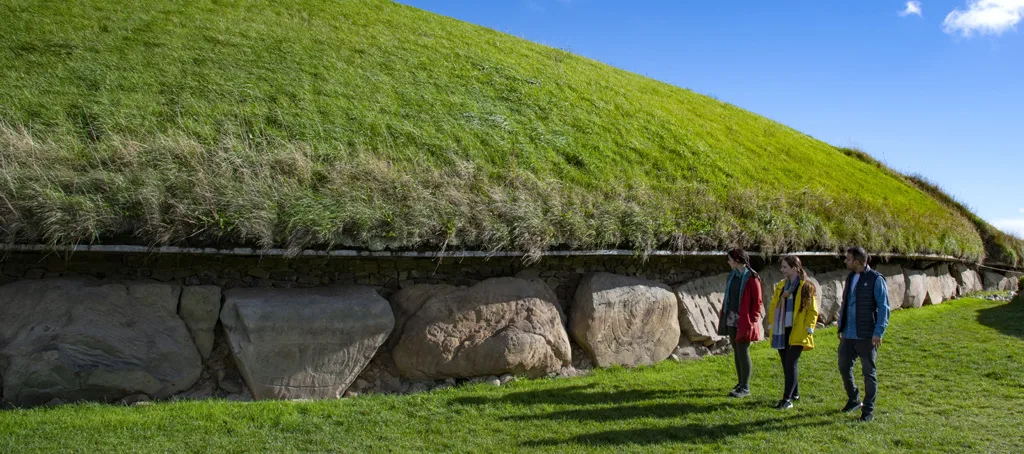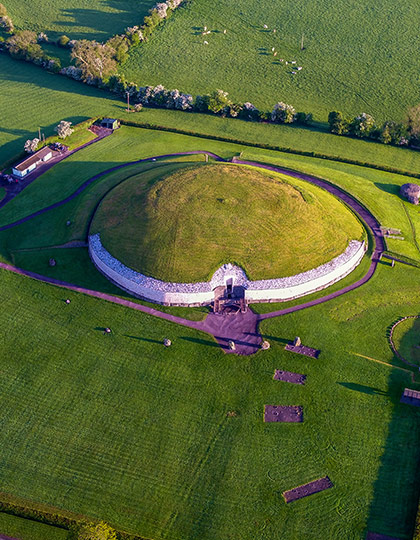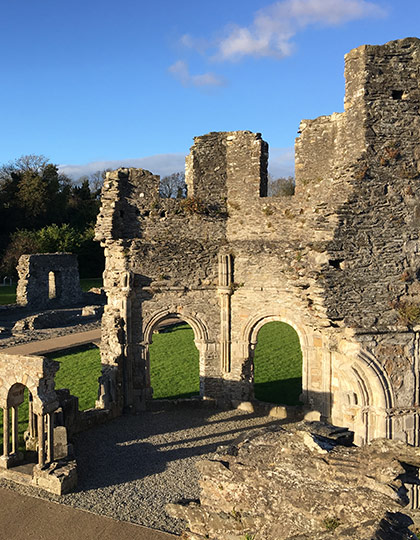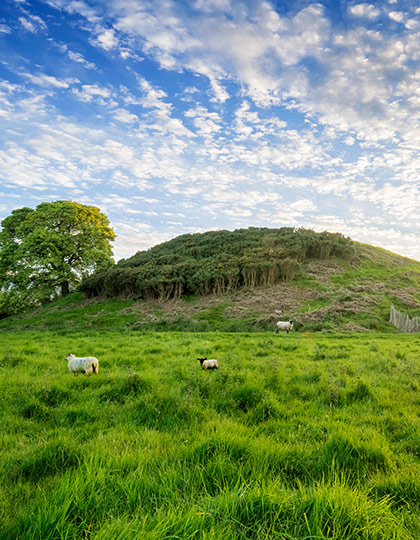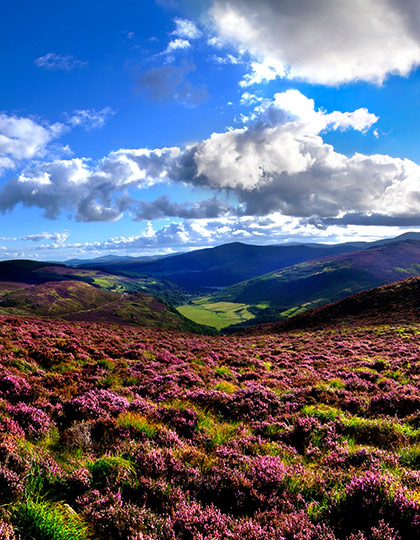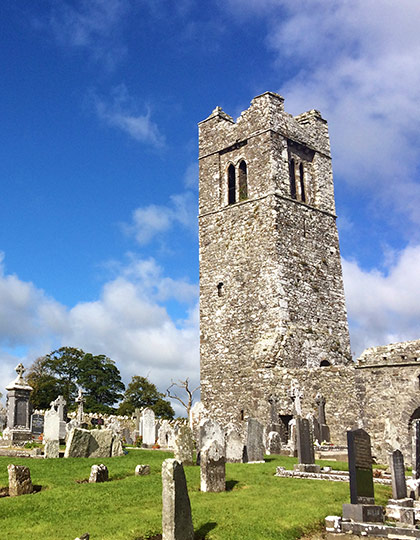This website uses cookies to help deliver its services. By using this website, you agree to the use of cookies as outlined in our Privacy Policy.
Knowth Megalithic Passage Tomb Kerbstones
The kerbstones at Knowth are large stones that encircle the base of the mound, many of the 127 kerbstones are decorated with intricate carvings, creating a visual record of the artistic and symbolic expressions of the neolithic people who constructed the mound over 5,000 years ago.
Knowth Kerbstone 5
In the center there is a clockwise spiral of six turns, with an outer arc at the bottom. The spiral is flanked on each side by C-shaped motifs/gapped circles, opening against the spiral. Each encloses a long oval/rectangular motif. The C-motif on the right is the more complex, with an outer C enclosing two sets of double closed Cs. The C-motif on the left is simply doubled. A gapped double circle is squeezed low down between this and the spiral.
At the top-right of the stone there is a row of seven small circles; that on the right is picked on a flaked surface. At the top-left corner of the stone there is a small U and a gapped circle. The main tool used on this face had a small-to medium-sized, rounded point, but in some cases a chisel with a narrow cutting edge was also used. In some cases the pickmarks merge to form a ribbon. Some dispersed marks on the top and the right half of the main face may be natural.
Knowth Kerbstone 7
A series of circles, arcs and U-shaped motifs are picked on the upper two-thirds of the surface of this stone. The picking is done with both small and broad points, and in places the pickmarks merge together to form a ribbon-like line. Some patches of Close Area-picking occur on the upper part of the stone. From the left, the motifs comprise a double gapped circle and two large, double concentric circles with two smaller circles between them, the upper one being gapped.
To the right is another small single circle, with a double circle beneath. To the right of this, two gapped double circles open towards each other to form a distinctive motif like a figure of eight. Above these is a double semi-circle opening downwards, a gapped circle, and three large, boxed Us opening downwards towards a fourth U. Near the top-right is another small, gapped circle. On the lower-right of the stone there are a number of deep pickmarks.
Knowth Kerbstone 11
Stage 1 comprises a number of motifs, which underlie the Stage 2 carvings that dominate the stone. They include an incised grid pattern on the left of the main face, with a smaller example just to the right, Low down is a lightly picked two-turn clockwise spiral enclosed in an arc (or possibly a third turn of the spiral). A vertical row of chevrons runs down the center of the main face of the stone. On the top surface, to the left is a double circle with an arc between the circles and two further arcs outside them.
Stage 2: the carving belonging to this stage occupies both the whole of the stone’s main surface and its top, and is arranged around the natural contours of the stone. The picked lines are broad and ribbon-like. A vertical line slightly right of center is placed in a natural hollow of the stone and continues onto the top surface. A narrower line lies parallel to it on the right, and there is a short, vertical line between the two. Two large motifs occupy the resulting spaces on the stone.
That on the left is more complete, and from the center outwards consists of a gapped circle, another around this with slightly squared upper corners, and a third, which is distinctly squared on the top-right. Five boxed rectangles, which are open at the bottom, enclose this, again with the top-right corner being more angular than the top-left. An arc runs between the second and third rectangle from the outside. At the bottom-left these clearly overlie the stage 1 spiral. The right half of the stone has a similar motif, but this is incomplete on the lower-right, where the stone is very irregular. All these rectangles are deeply picked (averaging 10mm in depth), and the natural surface stands out as ridges between the picked channels/ribbons.
Knowth Kerbstone 13
Three stages of carving can be tentatively identified on this face. Stage 1: incised lines between many of the picked lines seem to precede them, but the full extent of the incised lines is difficult to determine because they are obscured by the picked motifs. Stage 2: the whole surface of the stone is covered with picked motifs, many executed with a rounded point of small to medium-size, but close inspection shows that different types of points were used, and it is not clear if these indicate various stages of carving.
The motifs include lozenges on the top-left, with two anti-clockwise spirals below them, one of which overlies one of the lozenges. The middle of the stone is occupied by a dense series of angular motifs, including zigzags and lozenges. There is a quartered lozenge low down, and two of the opposing triangles inside it are picked all over. To the right is a panel of zigzags, and above these are three tightly set, double, anti-clockwise spirals, two of which are conjoined to form a double S-spiral, with a very lightly picked double spiral immediately to the right and a single anti-clockwise example further right.
Above the spirals are some small serpentiforms, a large zigzag, and some small arcs opening downwards. Stage 3: a wide serpentiform motif is deeply picked with a round point along the right edge and partly across the bottom of the stone and clearly overlies a number of motifs in this area. A patch of pick-dressing under the middle spiral may also belong to this stage, but it is not so deeply picked.
Knowth Kerbstone 15
Knowth Kerbstone 15 illuminated for the spectacular opening sequence of the RTÉ TV ‘Shine Your Light’ winter solstice special which was broadcast on the 20th December 2020. Projection mapping by Algorithm, photo by Ken Williams.
The dominant motif here is a semi-circle of twenty (one partial) picked lines radiating out from a small cupmark/dot. The radial lines widen outwards and all, except for two towards the left, terminate in a small rectangle. There are three extra rectangles towards the right. A larger square/rectangular motif is picked beyond each of the small rectangles, followed by another small rectangle. A second small cupmark is picked above the first. This is enclosed within a large oval motif, which is picked all over and is partially enclosed in an oval outer line which is doubled at the right.
At the upper-left of the oval there is a row of U-motifs, or possibly a small serpentiform, and a dot-and-circle. Beyond these, at the left of the stone, a row of circles curves outside the ends of the radial lines and two curved lines enclose the circles, to the left. To the right of the main face there is a large anti-clockwise spiral of seven turns. A number of motifs are arranged around the right side of the spiral. There are three small circles and an oval above it, and a series of single and double U-motifs to its right and below it. Further right is a small spiral with a series of zigzags above it, and a small, irregular circle above to the right. Below the spiral there are eight circles, one with a central dot.
Knowth Kerbstone 34
Stage 1 comprises a number of motifs, which are lightly picked with a medium-sized point; the carvings at the top of the stone are very weathered. There are traces of four sets of two or three concentric circles across the middle of the stone. Above them to the right are two more sets of smaller concentric circles, and to the lower-right are two small, double concentric circles. There is a short zigzag below the main row of circles.
Stage 2 consists of a double spiral motif of four-and-a-half turns. This is picked with a heavier rounded point than the stage 1 carving, and the lines are wider and more deeply picked. Low down on the stone is a panel of lightly incised, vertical lines, with some short, incised zigzags. As there is no superimposition, it cannot be determined at what stage these were carved.
Knowth Kerbstone 38
Most of the carving was lightly picked with a rounded point. There are two very finely picked small circles at the lower-left. To their right there are two lightly picked zigzags separated by a horizontal line and surrounded by a polygon. Above this is a short spiral of two turns. At the right of the stone, two sets of zigzags are arranged to form lozenges, and three small arcs/circle motifs. An anti-clockwise double spiral motif is much more deeply picked than the other carvings, and although it does not directly overlap the more lightly picked motifs, it seems likely that it may have been done at a later date than them. It is similar to the deeply carved central spiral on Kerbstone 34. Some dispersed pickmarks occur on the face.
Knowth Kerbstone 42
On the main face there are two slightly curved rows, each of which is composed of eight single circles picked with a medium-sized, rounded point. There are also some dispersed pickmarks.
Knowth Kerbstone 46
Stage 1 consists of a set of at least three large, lightly picked, concentric circles on the top-left of the stone. Low down on the stone, mostly now below ground level, a semi-circle of roughly picked radial lines was recorded, one of which curves over and then downwards in an arc. Stage 2 consists of a row of three picked, anti-clockwise double spirals, averaging two-and-a-half turns each, two of which overlie the lightly picked concentric circles. There are also a number of dispersed pickmarks.
Knowth Kerbstone 51
Stage 1 comprises a central, finely picked, double anti-clockwise spiral of two-and-a-half turns. This is seems to be overlaid in Stage 2 by the central elements of a row of arcs that runs across the stone. Above these is a long, horizontal serpentiform, and above that a row of circles is picked just below the top edge of the stone. The four circles on the left are single and quite wide, and the three on the right are double.
There are also a number of penannular circles along the right edge, one of which links to a deeply picked, short, horizontal zigzag. Some further motifs may be noted under the row of penannular circles, including an oval, a possible spiral, and an irregular motif at the left end of the zigzag. These motifs are very lightly picked with a fine point, sometimes drawn along to make a short, sharp line, as are parts of the zigzag, and they might therefore belong to Stage 1, like the spiral. The majority of the motifs are picked with a medium-sized, rounded point.
Knowth Kerbstone 52
Stage 1 comprises a central, finely picked, double anti-clockwise spiral of two-and-a-half turns. This is seems to be overlaid in Stage 2 by the central elements of a row of arcs that runs across the stone. Above these is a long, horizontal serpentiform, and above that a row of circles is picked just below the top edge of the stone. The four circles on the left are single and quite wide, and the three on the right are double.
There are also a number of penannular circles along the right edge, one of which links to a deeply picked, short, horizontal zigzag. Some further motifs may be noted under the row of penannular circles, including an oval, a possible spiral, and an irregular motif at the left end of the zigzag. These motifs are very lightly picked with a fine point, sometimes drawn along to make a short, sharp line, as are parts of the zigzag, and they might therefore belong to Stage 1, like the spiral. The majority of the motifs are picked with a medium-sized, rounded point.
Knowth Kerbstone 56
A number of motifs are picked on the main face of the stone, and the overall impression is one of an unusually well-planned and rhythmic whole. A medium-sized or large, rounded point is most commonly used, but the pickmarks near the top of the stone are shallower, probably due to weathering. There are five anti-clockwise spirals, three in a row and two in the spaces beneath them.
From the left, the motifs comprise a large spiral of five turns; the outer end of the spiral then doubles back for two-thirds of the way around the spiral and there is a short outer arc at the lower-left. To the upper-right of this there is a spiral of three-and-a-half turns, with a double circle below it, and lower down a spiral of four-and-a-half turns, which also doubles back on itself for two-thirds of a turn and then doubles back again for about a quarter turn.
In the middle of the stone is a spiral of five-and-a-half turns, and beyond this, to the right, are two spirals of three turns each. The space to the right of the middle spiral has a double circle at the top, with a small circle below, then a wedge shape with rounded corners, and below that a semi-circle facing down towards a set of four concentric arcs. Three chevrons are picked between the two spirals at the right.
Knowth Kerbstone 67
The surface of the stone shows a number of cracks and some flaked surfaces. Stage 1 consists of an irregular arrangement of nested, incised triangles near the top-right corner of the stone. This is overlain by one of the spirals of Stage 2. These are all picked, using a tool with a medium-to-fine, rounded point. Chisels were also used, some having a narrow cutting edge and others with a broader edge.
From left to right, the picked motifs comprise a clockwise spiral, an anti-clock-wise spiral of four turns, and a set of three, concentric circles touching this on the right. Below there is an anti-clockwise spiral of three-and-a-half turns, then the biggest, centrally placed clockwise spiral of four turns, with another smaller one of four turns to the right and another of three turns further right. Lower down to the right is a small U, opening upwards, and near the top of the stone is a double U-motif opening downwards. Near the left side of the stone there are some dispersed pickmarks.
Knowth Kerbstone 78
A serpentiform is picked with fine, dense pickmarks parallel with most of the top edge of the stone. In the top-right corner, on lower plane of the stone, is a double U-motif opening downwards, with six curving lines on the left opening towards the Us. Below the long serpentiform there is a row of circular motifs, comprising seven single U-motifs all opening downwards, and three single circles.
To the lower-right, a short serpentiform motif runs to the right edge of the stone. On the left is a double serpentiform motif running from the left edge to the middle of the stone. Each end of the upper serpentiform doubles back and meanders; the one on the right curving around one of the Us in the row above, while on the left the end of the serpentiform doubles back on itself in a loop and then loops up and down the left edge of the stone. A circle enclosed in two gapped circles separates the two serpentiform motifs, and a double semi-circle is picked lower down to the right.
Below these is a serpentiform whose left end doubles back over itself, and to the left is another short serpentiform. The lower-right angle is pick-dressed, as is the base of the recessed area in the top-right corner. Most of the carving is done with a medium-sized, rounded point. There are some dispersed pickmarks in the middle of the stone.
Knowth Kerbstone 79
Stage 1: A lightly picked and somewhat weathered serpentiform runs across the middle of the stone and underlies some of the later carvings. Stage 2: A broad line curves along the left side of the face and turns onto the top, where it dips down to a V and then straightens to form a short, horizontal line. The line encloses a large double C-shape with a gapped circle inside; a short horizontal line is picked in the gap between the ends of the C. Below this is a comma-shaped motif.
To the right of the set of gapped ovals there is a large oval, picked with very wide, ribbon-like lines. This encloses two circular motifs, the upper a circle framed by two arcs on each side, with a similar motif below but with two concentric circles, and an arc only on the left. Below the oval is a clockwise spiral of four turns. The next set of motifs, in the center of the stone, from the top downwards, are an upward-opening U-motif; a clockwise spiral of three turns, which is somewhat compressed laterally; and below this two wide, boxed, U-motifs. To the right, the next group of motifs has a circle at the top, with a narrow, upright rectangle and a double concentric circle below it. Most of the picking on this Stone is done with a small to medium-sized, rounded point.
Knowth Kerbstone 81
A long serpentiform motif enclosed in a gapped, rectangular frame is picked across the upper part of the stone. The bends in the center of the serpentiform are set close together, but at each end the bends become more splayed out. More than one phase of carving may be a factor here, as the picking of the serpentiform also shows differences, with the pickmarks set closely together in the center but much more widely spaced at each end, particularly on the right.
Different techniques were also used for the rectangle; a chisel with a narrow cutting edge and a medium-sized point were used for the bottom line, while a chisel with a medium cutting edge was used for the top line. On the left this was made with a series of short, vertical marks. A short, horizontal line is picked along the right shoulder of the stone. Part of the lower-left corner of the rectangle is flaked off, and there are a number of dispersed chisel marks in that area.
Knowth Kerbstone 84
Stage 1 comprises a series of faintly incised sines on the center-right of the main face. Some lozenges and zigzags can be identified. Stage 2 consists of a large, circular motif occupying the main face of the stone. A range of techniques can be noted, with some of the pickmarks being distinct and well-formed and others ill-defined. A medium-sized, rounded point was used, and also a chisel with a medium-sized cutting edge. The motif has two central, concentric ovals with five enclosing arcs on the left and six on the right. Originally, the innermost at least of these might have been complete at the top, but the upper part of the stone is now missing. A small semi-circle is picked low down in the gap between the outermost arcs.
Knowth Kerbstone 86
A set of four boxed lozenges is incised in the lower-left quadrant of the stone. This is not directly overlaid by the picked motifs, but the incised lines are interrupted by some dispersed pickmarks, so it seems likely that the picked motifs were applied at a later stage than the incised motifs. The picked carvings on this stone are very distinctive, and comprise four large, symmetrically placed crescent or C-shaped motifs.
They are separated by a horizontal line, which has a small dot at each end. A dot is also placed just above and below the line, between the C motifs. The two upper Cs are picked with a medium-sized, rounded point, and they are weathered along the top of the stone. The picking of part of the horizontal line and of the lower Cs is very closely set, making a continuous ribbon. A slightly narrower picked line frames the Cs but is missing at the top-left where the stone is fractured, and along the top where it may have been lost through weathering.
Knowth Kerbstone 89
The stone’s surface is mostly uneven and cracked, but some areas are relatively smooth. There are ten circular motifs; however, parts of several of them are weathered, particularly at the top of the stone. At the left end of the stone is a motif with four concentric elements. To its upper-right is a set of three concentric circles, the inner complete and the two outer ones incomplete where they run against a natural depression.
Below this is a set of four concentric circles, with a similar set just to the right. Above this there are two small single circles, and above those a set of three, lightly picked, gapped circles. Lower down to the right is a set of three concentric circles, with an additional arc on the right side. To the lower-right there is another set of three, deeply picked, gapped circles. A set of three, shallow picked, concentric arcs near the top-right corner of the stone opens to the left onto a weathered area, and these may have been more extensive originally.
Knowth Kerbstone 91
A single serpentiform of seventeen bends is picked across the stone with a range of rounded points. At the right end, the serpentiform curves down for a short distance along the edge of the stone.
Knowth Kerbstone 93
The stone has a marked horizontal arris, and the carvings on the upper part of the stone are noticeably more weathered than those lover down. The principal motif is an eighteen-bend serpentiform running across the stone, and beneath this is a horizontal line that turns up at each end. Above the serpentiform is a row of six single arcs, and further right are two double arcs and one single; all the arcs open to the side.
Above these, from the left, is a double concentric circle, then three concentric circles, and between this motif and the next to the right there may have been a circular motif; there are also the remains of some short, curved lines, which may have been part of an earlier motif. The next motif to the right is an anti-clockwise spiral, which turns back on itself, with some short lines and curves just to the right. The motifs on the upper slope of the stone are picked with a small to medium-sized point, and on the lower part with a medium-to-large point, and there are also some elongated marks made with a chisel.
Knowth Kerbstone 94
The upper part of the stone is weathered and the motifs here are not clear, At the top-center there is a set of three concentric circles/arcs, the upper parts of which are very faint. These are enclosed by three/four shallow arcs on the left. To the right is another set of three concentric circles or arcs, and further right is a double concentric circle.
A row of three larger motifs runs below the top row; all are variants of concentric ovoids, gapped at the top. Below this row are two small sets of double gapped circles, symmetrically placed between the larger motifs. The picking on the lower part of the stone is better preserved than on the top of the stone and is done with medium/large points. Chisels with a broad-to-medium cutting edge were also used, and some triangular pickmarks may be noted on the right side.
Knowth Kerbstone 118
Across the middle of the stone, a horizontal serpentiform is picked with a medium-sized, rounded point. At the left end, the line widens and bifurcates, with a small, wavy line extending upwards. A short, sloping line is picked higher up on the stone.
Text Credit
Description of megalithic art on kerbstones from Excavations at Knowth Volume 7: The Megalithic Art of the Passage Tombs at Knowth, Co. Meath




